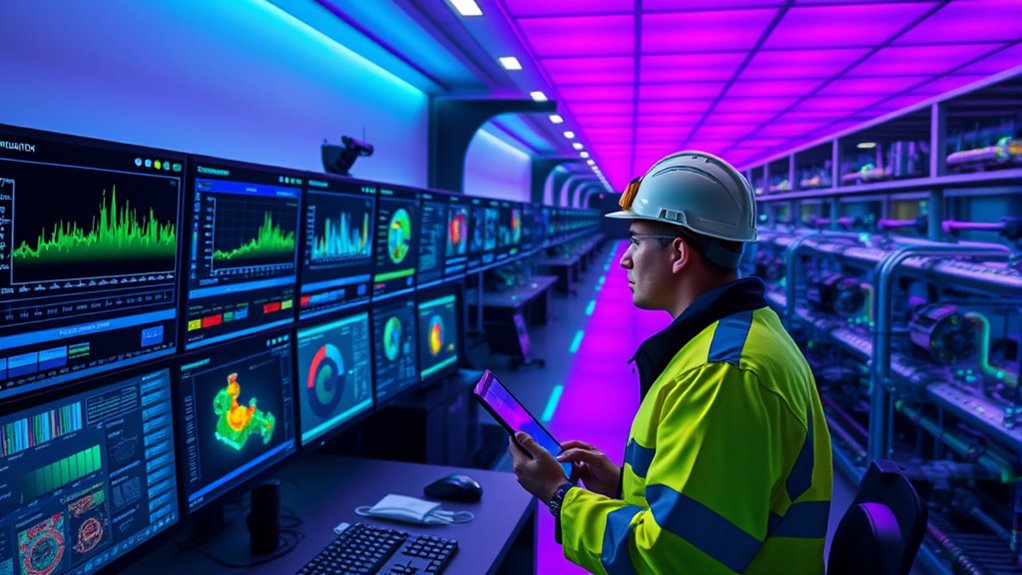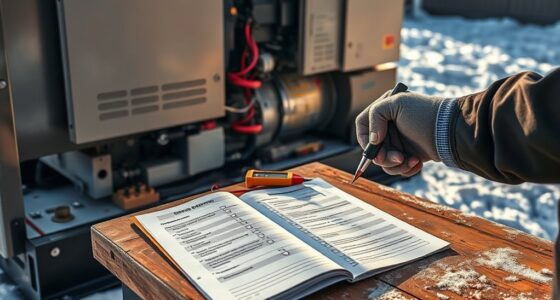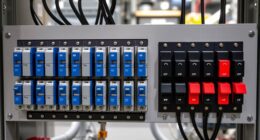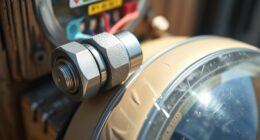Remote monitoring for preventive maintenance allows you to track your equipment’s performance in real time using IoT sensors, helping you detect issues early before they become costly failures. By analyzing data patterns and setting alerts, you can respond proactively, reducing downtime and extending asset life. Centralized monitoring simplifies management across multiple locations and enhances operational efficiency. Keep exploring to discover how implementing these technologies can optimize your maintenance strategies effectively.
Key Takeaways
- Enables real-time tracking of equipment performance to detect issues early and prevent failures.
- Utilizes IoT sensors to collect continuous data on parameters like temperature, vibration, and pressure.
- Analyzes data patterns to identify anomalies, supporting proactive maintenance scheduling.
- Sends instant alerts and notifications for critical parameter deviations, facilitating quick response.
- Provides centralized monitoring of multiple assets, improving operational efficiency and decision-making.

Remote monitoring has become a critical tool in preventive maintenance, allowing you to track equipment performance in real-time without being physically present. By leveraging IoT sensors, you can gather continuous data directly from your machinery and systems. These sensors are embedded in essential components, measuring parameters like temperature, vibration, pressure, and humidity. The real power lies in how this data is analyzed: sophisticated data analysis tools process the incoming streams of information to identify patterns and anomalies that might signal potential failures. This proactive approach enables you to address issues before they escalate into costly breakdowns or downtime.
Remote monitoring with IoT sensors enables real-time equipment tracking and proactive maintenance.
When you install IoT sensors on your equipment, you create a network that constantly transmits indispensable data to your central system or cloud platform. This seamless connectivity ensures you get up-to-the-minute insights into your asset health. The data analysis part is indispensable because raw data alone doesn’t provide actionable insights. Advanced algorithms sift through the information, filtering out noise and highlighting deviations from normal operation. For example, a gradual increase in vibration levels could indicate bearing wear, prompting you to schedule maintenance before a failure occurs. This predictive capability reduces emergency repairs and extends the lifespan of your assets.
With remote monitoring, you gain the ability to set up alerts and notifications based on the data trends. If sensors detect a parameter crossing a predefined threshold, you’re immediately notified via email or mobile alerts. This instant communication allows you to respond swiftly, whether that means scheduling maintenance or adjusting operating conditions. Over time, the accumulated data and analysis help you understand your equipment’s behavior patterns, enabling you to fine-tune maintenance schedules and optimize operational efficiency.
Furthermore, IoT sensors and data analysis facilitate a centralized view of all your assets, regardless of their location. This consolidated oversight simplifies management and improves decision-making. You no longer need to rely solely on manual inspections or waiting for equipment to fail before acting. Instead, you’re empowered with continuous, accurate insights that keep your operations running smoothly.
Frequently Asked Questions
How Secure Is Remote Monitoring Data From Cyber Threats?
Remote monitoring data is quite secure when you implement strong cybersecurity protocols and data encryption. These measures protect your information from cyber threats by ensuring that data is encrypted during transmission and storage. Regular updates and access controls further strengthen security. You should stay vigilant, keep systems updated, and follow best practices to minimize risks. With proper security protocols, your remote monitoring data remains safe from cyber threats.
What Are the Initial Costs to Implement Remote Monitoring Systems?
Implementing remote monitoring systems typically costs between $10,000 and $50,000, depending on your equipment and needs. About 60% of companies find that initial investments in technology and installation are the main expenses. Your cost estimation should include equipment expenses like sensors, communication devices, and software setup. While these costs may seem high upfront, they often lead to significant savings by preventing costly breakdowns and reducing downtime.
Can Remote Monitoring Systems Integrate With Existing Maintenance Software?
Yes, remote monitoring systems can integrate with your existing maintenance software. You need to check system compatibility to guarantee smooth data integration. Most modern remote monitoring solutions offer APIs and compatible interfaces that connect seamlessly with popular maintenance platforms. This integration allows you to access real-time data, streamline workflows, and improve preventive maintenance efficiency without overhauling your current systems.
How Do Remote Monitoring Systems Handle False Alarms or Data Inaccuracies?
While false alarms can be frustrating, remote monitoring systems combat this with false alarm mitigation techniques and data accuracy verification. They analyze sensor data rigorously, filtering out anomalies before alerts are sent. By cross-referencing multiple data points, these systems guarantee accuracy and reduce false positives. Consequently, you gain reliable insights, minimizing unnecessary maintenance and enhancing overall operational efficiency. This proactive approach helps maintain your equipment’s integrity and trust in the system’s alerts.
What Training Is Required for Staff to Operate Remote Monitoring Tools Effectively?
You need staff training and technical certification to operate remote monitoring tools effectively. Focus on hands-on training sessions that cover system functionalities, troubleshooting, and data interpretation. Make certain your team understands how to respond to alerts accurately and maintains system security. Regular refresher courses keep skills sharp. By investing in proper training and certification, your staff becomes confident, reduces errors, and maximizes the benefits of remote monitoring in preventive maintenance.
Conclusion
By embracing remote monitoring, you shift from reactive fixes to proactive prevention. It’s like having a watchful eye that catches issues early, saving you time and costs. But remember, this technology isn’t a magic cure; it’s a tool that requires your vigilance. The power lies in your hands—balancing automation with human insight. In this dance of data and decision, your attentiveness transforms a simple system into a reliable partner in maintenance.









